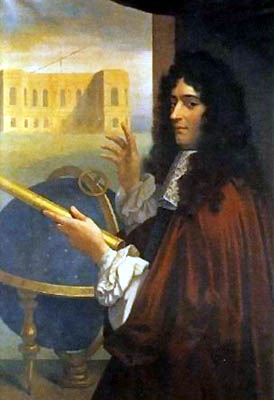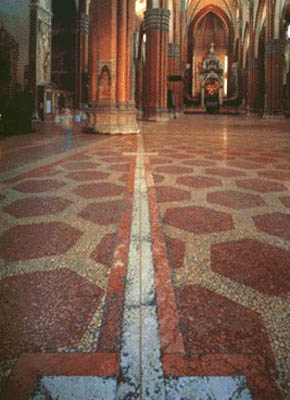The day of Easter was set in 325 A.D. but it immediately presented a problem for scientific types; it's darn hard to calculate the date in the future when the Earth is the center of the universe. So planning spring break trips to Cabo was tough. By the 16th century the calendar itself clearly needed reform, and the Gregorian calendar was adopted in 1583 A.D. thanks to Pope Gregory XIII and astronomer-mathematicians like Lilius and Clavius, but it was up to other scientists to monitor its accuracy. Enter Giovanni Cassini in 1651, who installed a pinhole camera in the roof of the San Petronio cathedral in Bologna in Italy.

Though important for Easter calculations, Cassini is better known for discovering the Saturnian satellites Lapetus in 1671, Rhea in 1672, and both Tethys and Dione in 1684. In 1675 he discovered what is now known today as the Cassini Division - Saturn's rings are split largely into two parts by a narrow gap and that the rings were in fact swarms of tiny moonlets too small to be seen individually. Credits: Observatoire de Paris
Cassini also observed the Sun’s image projected on to the cathedral floor to try to confirm the theories of Johannes Kepler, the German astronomer who proposed in 1609 that the planets moved in elliptical orbits. By watching the Sun’s projected disc on the cathedral floor shrink and expand as it traveled across the stone, Cassini was able to deduce that the distance between the Sun and Earth did not remain the same, proving that a circular orbit was out of the question.
After thousands of observations, Cassini was able to prove that Kepler’s theories were correct and he became the first person to make a reasonably accurate calculation of the distance between the Sun and the Earth. This clobbered what was left of classical cosmology and opened the door for modern celestial mechanics, but Cassini was the latest in a long line of European scientists deducing the science behind religious belief, notably following in the footsteps of Nicolaus Copernicus, who upset everybody in 1543 when he placed the Sun near the center of the Universe, with planets in orbit around it.

In this Sun calendar, a hole in the ceiling of the cathedral projects a shaft of sunlight onto this bronze strip on the pavement below which is engraved with the days of the year and signs of the zodiac. The Basilica of San Petronio is in Bologna, Italy. Credits: Calter Photo
Cassini’s observations also allowed exact calculations of future equinoxes on the Gregorian calendar to be made in advance, thus helping to solve the ‘When’s Easter?’ problem.
But why then? Well, Easter must occur on a Sunday because Sunday was the day of Christ's Resurrection but the paschal full Moon is another issue entirely. The Bible is the answer - the paschal full moon was the date of Passover in the Jewish calendar, and the Last Supper (what Christians call Holy Thursday) occurred on the Passover. Therefore, Easter was the Sunday after Passover.
Since this is a 'moving' feast rather than a hard date like Christmas, it can get tricky. Today, we have different timezones so Easter could be on different days if those are factored in. Obviously a bad thing. So, for calculation purposes, the full moon is always set at the 14th day of the lunar month (because the lunar month begins with the new moon) and so the Church might set the date of the vernal equinox at March 21, even though it can occur on March 20 but it lets them set a universal date for Easter.
Of course, that is western Christianity. The Eastern Orthodox folks use the older Julian calendar so March 21st on the Julian calendar is actually April 3rd on the Gregorian calendar. But this year, to the relief of anyone who really cares, they fall on the same day. Next year they will be a week apart.
Prior to 325 AD when the date was fixed Easter occurred either on or just after the first day of the Jewish Passover no matter which day of the week that Easter Day occurred or on a Sunday close to or on the first Passover Day.
You can do the math yourself, with this handy guide from the University of Texas:
First, calculate the Golden Number G. This is fundamental to the calculation of both the date of Easter and the Date ofRosh Hashanah. It is intimately connected with the Metonic Cycle. For any year Y, the Golden Number is defined as
- G = Remainder(Y|19) + 1. Don't forget to add the 1!!!
For example, in the year 1996, the Golden Number was 2 becauseRemainder(1996|19)=1. Next, compute S, where
- S=Remainder((11G + C)|30), and in the 20th through the 22nd century, C=-6. A table for C and a rule for calculating C are given below.
- Important Note: S must be nonnegative. If you get a negative number, add an appropriate multiple of 30 to make S between 0 and 29 (inclusive).
For example, in 1996, S=Remainder((22-6)|30)=16.
Then, the Paschal Full Moon falls on the date (March 50=April 19) - S, except that if this formula gives April 19, the Paschal Full Moon falls on April 18 instead, and if the rule gives April 18, and if G is greater than or equal to 12, the Paschal Full Moon falls on April 17.
Then Easter is the first Sunday that falls after this date (if the date you calculated is a Sunday, then Easter is one week later). For example, in 1996, the Paschal Full Moon falls on April 19-S= April 19-16 = April 3. Conway's Doomsday Rule tells us that April 3 is a Wednesday that year, so Easteris the next Sunday, or April 7.
Here's how to determine C:
- In all Julian Calendar years, C=+3. This gives us Julian Easter. Note that Julian (Orthodox) Easter may not fall on the same actual day as Gregorian Easter, because the rule for Gregorian Easter is different. Julian Easter is celebrated by the Orthodox Church.
- In years 15xx, 16xx of the Gregorian Calendar, C=-4 (note the negative sign).
- In years 17xx, 18xx of the Gregorian Calendar, C=-5
- In years 19xx, 20xx, 21xx of the Gregorian Calendar, C=-6
For Gregorian dates in other centuries, where the year is Y=Hxx, calculate C as follows:
- C = [H/4] + [8(H+11)/25] - H (note the square brackets!)




Comments